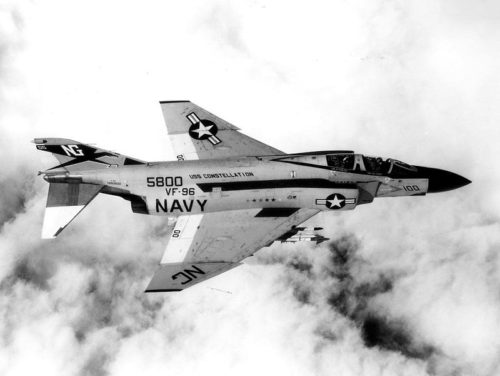May 10 in U.S. military history
1775: The famous Vermont guerrilla force the “Green Mountain Boys”, commanded by Col. Ethan Allen, and state militiamen led by Col. Benedict Arnold catch the British troops at Fort Ticonderoga (present-day Ticonderoga, N.Y.) by surprise. The Americans charge into the fort, chasing off the lone sentry and begin disarming the sleeping defenders.
When the British commander demands to know under what authority are the men entering, Allen replies, “The Great Jehovah and the Continental Congress!” The strategic fort is captured without a shot fired. The cannon and armaments are sent to Boston where they will be used to break the British siege.
1797: The 55-gun heavy frigate USS United States is launched at Philadelphia, becoming the first commissioned ship of the U.S. Navy. The warship will see action during the Quasi-War with France, the Barbary Wars (see entry below), and the War of 1812 before she is seized by Confederate forces in 1861 and re-christened CSS United States.
1801: Following Thomas Jefferson’s inauguration, Yusuf Karamanly — the Pasha of Tripoli — demands tribute from the United States to prevent the Barbary pirates from continuing their practice of taking hostages and capturing ships. President Jefferson refuses, and the Pasha declares war.
1863: Eight days after he is mistakenly shot by Confederate sentries following the Battle of Chancellorsville (Va.), Gen. Thomas “Stonewall” Jackson dies from pneumonia. In the Battle of Horseshoe Bend (Ky.) Maj. Byron M. Cutcheon of the 20th Michigan infantry leads a charge and earns the Medal of Honor. By war’s end, Cutcheon will receive a brevet promotion to Brigadier General of volunteers, and later becomes a U.S. Congressman.
1864: During the Battle of Spotsylvania Court House, Capt. Abraham Arnold of the 5th U.S. Cavalry earns the Medal of Honor when he leads a gallant charge against a numerically superior enemy which “extricated his command from a perilous position in which it had been ordered.” Arnold will later serve during the Indian Wars and leads the 2nd U.S. Division in Cuba during the Spanish-American War.
That same day at Laurel Hill, Va. two more soldiers earn the Medal of Honor: Sgt. Moses A. Luce of the 4th Michigan Infantry charges forward in the face of an advancing enemy to rescue his wounded friend, Sgt. Asher LaFleur, carrying him to safety. Meanwhile, the 3rd Vermont Infantry’s Col. Thomas O. Seaver – in command of three regiments – attacks and occupies Confederate defensive works under “galling” enemy fire. Both Seaver and Moses become lawyers after the war.
1865: Union cavalry troopers capture Jefferson Davis, the president of the Confederate States of America, near Irwinville, Ga. Davis is charged with treason and held at Fort Monroe, Va. for two years until President Andrew Johnson pardons him on Christmas Day.
The federal government drops their case against Jefferson in 1869. Prior to the Civil War, Col. Davis served in the Mexican-American War and Pres. Polk offered him a promotion to brigadier general, which Davis refused. He would also serve as a U.S. Senator and the Secretary of War.
1866: Seaman Richard Bates, Seaman Thomas Burke, and Captain of the Afterguard (a petty officer in today’s Navy) John Brown rescue two drowning sailors off the coast of Maine — each earning the Medal of Honor. Bates is a native of Wales, Brown hails from Denmark, and Burke is a former Irishman.
1945: As the fighting rages on Okinawa in 1945, Navy corpsman William D. Halyburton Jr. charges through a “merciless barrage” of mortar, machinegun, and sniper fire to assist a wounded Marine. Halyburton uses his own body to shield his comrade while treating the fallen Marine, sacrificing himself so his patient could live.
1960: The nuclear-powered radar picket submarine USS Triton (SSRN-586) returns to port after completing the first-ever completely submerged circumnavigation of the Earth. Skippered by Capt. Edward L. Beach Jr. – a Navy Cross recipient and best-selling author of “Run Silent, Run Deep” – Triton has followed a trek closely paralleling that of the first-ever global circumnavigation led by Portugese captain Ferdinand Magellan in the 16th century. The submarine covers the 26,723 nautical mile journey in just 60 days and 21 hours, averaging 19 knots.
1969: Soldiers of the 101st Airborne Division move into the A Shau Valley for what would become an intense ten-day battle against North Vietnamese Army on Hill 937 – dubbed “Hamburger Hill.” The Americans charge up the steep slopes 11 times before dislodging the heavily fortified defenders.
Although the U.S. forces inflict heavy casualties on the communists and survivors retreat into Laos, the U.S. military abandons the hill – which is retaken by the NVA four weeks later.
Following Hamburger Hill, the White House instructs its military commanders to avoid engagements that result in large American casualties as public support is dwindling for the war.
1972: After President Richard Nixon authorizes the Operation LINEBACKER I bombing campaign of North Vietnam, U.S. Navy fighters have their busiest day of the war, shooting down six enemy MiGs. F-4J Phantom pilot Lt. Randall H. “Duke” Cunningham and his radio intercept officer, Lt. (j.g.) William P. “Irish” Driscoll, score two victories becoming the only aces of the Vietnam War, and the only U.S. aviators to ever accomplish the feat using missiles.

The men are themselves shot down over enemy territory as they return to the carrier, and the military has to scramble to save their aces. Cunningham is one of America’s most highly decorated pilots, receiving the Navy Cross, two Silver Stars, 15 Air Medals, and the Purple Heart.